——— F ———
F – (1) The abbreviation for Fahrenheit. (2) The abbreviation for female. (3) The symbol for Farad.
f –the abbreviation for femto-, a metric prefix for 10‑15.
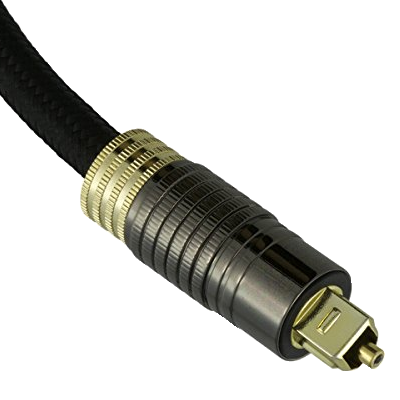
F05 – a connector for use with optical cable. Also called EIAJ/JEITA RC-5720, CP-1201, JIS C5974-1993 F05, and JIS F05.
fade – (1) The gradual change from one audio volume to another. There are three main types of fades: the fade down, the fade up, and the crossfade. (2) The fifth of the six segments of an AHDSFR envelope.
fade down – a fade in which the audio volume gradually decreases (which includes the fade out). .
fade in – the gradual increase in audio volume from silence to full level, often occurring during the introduction of a song.
fade out – (1) The gradual reduction in audio volume from full level to silence, usually occurring during the last several seconds of a song. (2) To gradually reduce the audio volume from full level to silence. Sometimes shown as fadeout.
fade up – a fade in which the audio volume gradually increases (which includes the fade in).
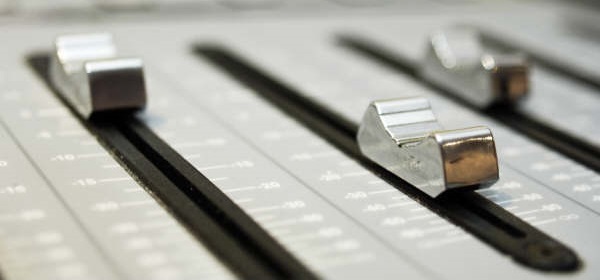
fader – a sliding control used to adjust the volume or signal level of a channel.
fader automation – see automation.
fader creep – slang for the tendency for an engineer when balancing a mix to raise the volume using the faders of several channels in a DAW, console, or mixer, rather than lowering the channels that are too loud.
fader riding – see riding faders.
Fahrenheit (F) – (1) A temperature scale in which water freezes at 32° and boils at 212° under standard conditions. It is named after the German physicist Daniel Gabriel Fahrenheit, who developed the temperature scale. Orginally its upper temperature was defined by the average human body temperature of 100°. (2) A unit of measurement (degree) using the Fahrenheit temperature scale.
Fairchild Recording Equipment Corporation – a company founded by Sherman Fairchild in 1931 in Whitestone, NY, that makes professional audio equipment. Fairchild's most notable products were the mono Fairchild 660 Compressor/Limiter and the stereo Fairchild 670 Compressor/Limiter.

Fairchild 670 Compressor/Limiter – a stereo compressor designed in 1959 by Rein Narma at the Fairchild Recording Equipment Company. Known for its silky smooth dynamic range compression, it is the most expensive compressor in the world and the heaviest at 30 kilograms (66 pounds). It is also known for variable-mu tube limiting, in which the compression ratio changes dynamically in response to the signal level. This results in a unique form of soft-knee compression that responds differently depending on the type of signal that is being fed. The mono version was the Fairchild 660.
Fairchild 666 Compressor – a mono optical compressor introduced by Fairchild in 1962. It had a hybrid design with a solid-state compressor followed by tube-based makeup gain stage with up to 40dB of compression. It also had “Auto-Ten,” auto attentuation to prevent pumping. It had a unique sound as a vocal compressor. It was an early acquisition of Abbey Road Studios and was used regularly at Motown Studios during their heyday.
fake book – a book or collection of pages containing information about songs, such as lyrics, melodies, and chord progressions, used by musicians in place of standard sheet music, used to learn a song or as a reference during a gig. Originally, fake books were illegal copies of music that musicians carried to gigs and jam sessions, but more recently publishers have begun compiling legal versions of fake books that are sold legally and do not infringe on any copyrights.
fake stereo – derogatory term for simulated stereo.
fall time – see decay time.
false note – see ghost note.
falsetto – (1) A method of singing used by male singers (and occasionally females) to sing notes higher than their normal vocal range. (2) A singer using falsetto. (3) A voice or sound that is higher than normal. (4) The vocal register above the normal voice (modal voice) register by about one octave.
FAME Studios – a recording studio located in Muscle Shoals, Alabama, founded in the 1950s by Rick Hall. Currently active and still owned by Hall, it was on the placed on the Alabama Register of Landmarks and Heritage in 1997 and listed on the National Register of Historic Places in 2016. FAME (Florence Alabama Music Enterprises) has had a large number of hit records and was largely responsible for the “Muscle Shoals sound.” See also Muscle Shoals Sound Studio.
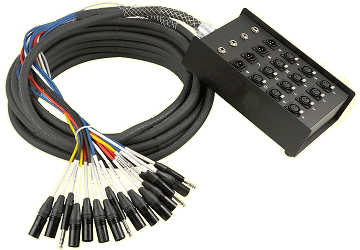
and Snake Box (R)
fan-out – the end of a multi-conductor snake where the individual conductors contained within the snake are broken out into separate connectors, with each wire often numbered or color-coded. A snake may have a fan-out on each end (one with male connectors and the other with female connectors) or, for large stage snakes, the stage end may have a snake box.
farad (F) – the SI unit of electrical capacitance, equal to the capacitance in which one coulomb of charge causes a potential difference of one volt. It is named for the English physicist Michael Faraday. Capacitors are usually measured in microfarads (μF), which is one millionth of a Farad.
Faraday shield – an electrostatic shield made by placing a conductive sheet or mesh around a device and connecting it to ground. The shield blocks external electric fields. One example is the braided wire around the conductors in audio cables. These shields are also used in transformers to block capacitance between the primary and secondary coils. They are sometimes used as a cage around sensitive electronic components on circuit boards. The shield is named for Michael Faraday, who invented it in 1836. Also called a Faraday cage.
Faraday cage – see Faraday shield.
far-end crosstalk (FEXT) – interference between an adjacent pair of wires in a cable measured at at the far end of the circuit. See also near-end crosstalk.
far field – that range of listening distances in which the predominant sounds reaching the ears are reflections from room boundaries (defined as the area between the free field and the reverberant field. See also near field.
far-field monitors – studio monitors (speakers) in which the sound is directed toward the room rather than to mix position. These monitors are generally used for overall listening, where the effects of control room acoustics are not the main concern. See also near-field monitors and midfield monitors.
FASA – Frequency, Amplitude, Spectrum, and Ambience. The sonic characteristics that can be adjusted to enhance an audio signal.
fast Fourier transform (FFT) – a mathematical algorithm that calculates the discrete Fourier transform (DFT) of a sequence, or its inverse (IFFT). The discrete Fourier transform is a function used to convert the representation of one type of sequence into another type of representation, such as a waveform in the time domain being converted into its representation in the frequency domain and vice versa. FFT is frequently used in spectrum analysis. Named for French mathematician and physicist Jean-Baptiste Joseph Fourier, who began the investigation of the Fourier series, a way to represent a function as the sum of simple sine waves.
fat – (1) A descriptive term for a sound that has more than a normal amount of low frequencies. (2) A sound that has been overly compressed. (3) A sound that has slight amount of analog tape distortion or tube distortion.
FAT – File Allocation Table. A special file located on a floppy disk or hard disk that indicates where information is stored for each piece of data, as well as the location of unusable areas on the disk. There are several FAT file formats, such as FAT-8, FAT-16, and FAT-32, which generally are used for 8-, 16-, and 32-bit systems respectively.
Faulkner array – a stereo microphone technique using a pair of figure-eight (bi-directional) microphones, both facing directly forward, but separated by about 8 inches (20 cm). Also called a Faulkner pair. It falls into the near-coincident pair category of techniques. Other techniques in this category include A-B, DIN, EBS, NOS, ORTF, RAI. See also coincident pair (Blumlein array, mid-side, X-Y pair) and spaced pair (A-B, Decca tree, spaced cardioids, spaced omnis). See table comparing various stereo microphone techniques.
Faulkner pair – see Faulkner array.
FC – see Fibre Channel.
FCC – Federal Communications Commission.
F clef – see bass clef.
FDDI – Fiber Distributed Data Interface. A standard for data transmission in a local area network using optical fiber to network thousands of computers at very high data speeds over great distances (miles).
FDHM – Full Duration at Half Maximum. See full width at half maximum.
Federal Communications Commission (FCC) – the US agency that regulates communications by radio, television, cable, and satellite.
feed – (1) The audio signal sent to a device. (2) To send an audio signal to a device.
feedback – (1) The squealing noise produced when a microphone picks up its own amplified signal from a loudspeaker. Also called acoustic feedback, howl, howlaround, howlround, howlback, or the Larsen effect after the man who discovered it. (2) A portion of an output signal returned to the input. (3) Feeding the output from a delay device back into the input creating multiple echoes. Also called regeneration or recirculation. (4) An output signal sent back to control an input signal.
feedback control – the control on a delay processor that adjusts the amount of delay.
feedback eliminator – see feedback suppressor.
feedback loop – the signal from a delay device returned to the input creating multiple echoes. See regeneration.
feedback suppressor – a signal processing device that reduces or eliminates acoustic feedback by detecting feedback frequencies and then inserting notch filters to eliminate the offending frequencies or by a continuous but minute shift of those frequencies to to prevent frequency build up. Also called a feedback eliminator.
feed reel – see supply reel.
feet and frames (feet:frames or feet+frames) – a method of tracking the position on a film. For example, both 122:14 and 0122+14 indicate a point 122 feet and 14 frames into the film. For 35-mm film, there are 16 frames per foot while 16-mm film has 40 frames per foot. If you know the frame rate, feet and frames easily can be converted into SMPTE timecode using H:M:S:F.

female connector – a connector attached to a wire, cable, or hardware device that has one or more recessed holes attached to electrical terminals into which a plug with exposed conductors (male connector) can be inserted securely making a good physical and electrical connection. Also called a jack, outlet, or receptacle.
femto- (f) – the SI prefix for a factor of 10‑15 or one quadrillionth. The term comes from the Danish word femten, meaning “fifteen.”

Fender Musical Instruments Corporation – a manufacturer of stringed instruments and amplifiers headquartered in Scottsdale, Arizona. It was founded in Fullerton, California, by Clarence Leonidas (Leo) Fender in 1946. It is especially known for designing and building solid-body electric guitars and bass guitars, including the Stratocaster (Strat), Telecaster (Tele), Precision Bass, and the Jazz Bass.
fermata – a symbol in music notation, consisting a dot surrounded by a semicircle, that indicates the note or rest beneath it should be held for an unspecified amount time, at the discretion of the performer.
ferric – short for ferric oxide.
ferric oxide – a dark-red, crystalline solid, with the chemical formula of Fe2O3. It has two main forms, alpha ferric oxide (α-Fe2O3) and gamma ferric oxide (γ-Fe2O3). Alpha is the most common form and occurs naturally as the mineral hematite, mined as the primary ore of iron. It is weakly ferromagnetic at room temperature. Gamma ferric oxide is ferromagnetic, metastable, and is converted from the alpha form at high temperatures. Among other uses, it is used in coatings for magnetic recording tape. Ferric oxide tapes are designated as Type I. Also called iron oxide.
ferrimagnetism – a property of some materials that have atoms with opposing magnetic moments that are unequal so that some magnetism remains. This occurs when the material contains atoms of different materials or ions (such as Fe+2 and Fe+3). Ferrimagnetism occurrs naturally in an oxide of iron called magnetite (Fe3O4). For magnets of the same size, ferromagnets usually have stronger magnetic fields than a ferrimagnets. Compare with ferromagnetism.
ferrite magnet – a permanent magnet made of ferrite, a ceramic compound composed of ferric oxide (Fe2O3) chemically combined with one or more additional metallic elements, which are both electrically nonconductive and ferrimagnetic. Ferrites are divided into two categories: (a) hard ferrites and (b) soft ferrites. Hard ferrites have high coercivity and maintain permanent magnetism, making them ideal for speakers and pickups. Ferrire magnets have a stronger magnetic field than alnico magnets, producing a higher output with a slightly increased treble response. Soft ferrites have low coercivity and are used in the electronics industry to make transformer cores and inductors. Sometimes called a ceramic magnet. See also rare earth magnet.
ferroelectricity – a property of some materials that can hold an electric polarization, which can be reversed by applying an external electric field. The term is analogous to ferromagnetism.
ferro fluid – a liquid that becomes strongly magnetized in the presence of a magnetic field. Ferro fluids are made of microscopic ferromagnetic or ferrimagnetic particles suspended in a liquid, typically an organic solvent or water. The magnetic particles are coated with surfactant to minimize clumping. When not in a magnetic field, ferro fluid has a consistency of oil, but in the presence of a strong magnetic field it becomes very viscous. Ferro fluid is sometimes used in loudspeaker drivers (particularly tweeters) to conduct heat away from the voice coil to allow much more power to be applied to the driver without burning it out. Ferro fluid was developed by by NASA in 1963. Sometimes spelled ferrofluid.
ferromagnetism – a property of some materials, such as iron, nickel, and cobalt, that become magnetized when exposed to a magnetic field and retain that magnetism when the field is removed. For magnets of the same size, a ferromagnets usually have stronger magnetic fields than a ferrimagnets. Compare with ferrimagnetism.
FET – Field Effect Transistor.
FET compressor – a type of audio compressor that uses field effect transistors in place of the vacuum tubes that were used in earlier designs or a plug-in that emulates such a compressor. FET compressors tend to preserve more transients which adds more punch as compared to vacuum tube compressors. FET compressors have faster reaction times than VCA and other compressors. FET compressors have no threshold control, with the amount of compression being controlled by the amplitude of the input signal—a louder signal results in more compression. The result is a very warm and rich sound character. FET compressors are frequently used on drums to add emotion, but they also are widely used on vocals and other instruments. An example of an FET compressor is the UREI 1176. They are useful for adding excitement and an aggressive sound, limiting, and parallel compression. The are not very transparent. See also tube compressor, VCA compressor, optical compressor, variable-mu compressor, PWM compressor, digital compressor, low-level compressor, and multiband compressor.
FFT – Fast Fourier Transform.
FHD – Full High Definition. See 1080i.
FHSS – Frequency-Hopping Spread Spectrum.

fiber optic cable – a cable made up of super-thin filaments of glass or other transparent materials that can carry light beams at the speed of light used to transmit data over longer distances with lower loss and at higher bandwidths than wire cables. Fibers are also immune to electromagnetic interference. A laser transmitter encodes digital signals into pulses of light that are translated back into data on the receiving end. See also fiber optics and optical audio cable.
fiber optic microphone – a microphone that converts acoustic waves into electrical signals by sensing changes in light intensity, rather than sensing changes in capacitance or magnetic fields as is the case with conventional microphones.
fiber optics – the technology of transferring data by modulating visible light sent through super-thin filaments of glass or other transparent materials. For short distances (less than 150 feet), plastic fibers can be used, while longers distances require glass fibers. Optical fiber carries much more information than conventional copper wire and normally is not subject to electromagnetic interference. British spelling is fibre optics.
Fibre Channel (FC) – a technology used for transmitting data between computer devices at data rates of up to 4 Gbps, especially applicable for computer servers to shared storage devices. Due to a lack of standardization, FC is being superseded by other less-expensive networking storage standards.
fiddle – see violin.
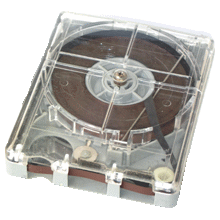
Fidelipac – a cartidge (similar in design to a 4-track or 8-track consumer cartridge) with an endless-loop ¼-inch-wide (6.4 mm) analog recording tape, usually in a two-track format with a speed of 7½ ips, used at one time by radio stations to play commercials, jingles, and other announcements. It was designed to automatically cue and sometimes to automatically start a second or third cartridge. Digital media have made the cartridge obsolete. Also called an NAB cartridge or simply cartridge and usually cart for short.
fidelity – the ability of a recording to duplicate the sound of the original sound.
field – (1) A region of space upon which a physical property exerts an influence, such as gravitational or electromagnetic field. (2) An element of a database record in which one type of information is stored. (3) A computer interface that accepts the input of text. (4) A sound field. (5) A video field.
field effect transistor (FET) – a transistor in which the output current is controlled by a variable electric field. It is used to amplify the signal of some microphones replacing vacuum tubes used in earlier designs. The use of FETs sometimes allows for the elimination of a transformer.
field rate – the frequency at which video fields are displayed on television systems: 59.94 Hz in NTSC, 50 Hz in PAL, 60 Hz in HDTV (United States, Canada, Japan, and most of Latin America), or 50 Hz (for Europe, Australia, much of Asia, Africa, and part of Latin America). For interlaced scans where the field is displayed twice for each frame, the field rate is twice the frame rate. In progressive scan, the field rate and frame rate are the same. So 1080 p has a field rate and frame rate of 60 Hz in the US. See also frame rate and refresh rate.
field recording – a recording made somewhere besides a recording studio.
fifth – in music, the interval that includes five positions on the music staff. (See interval number.) A fifth has a theoretical ratio of 3:2. However, in the equal temperament system, in which the notes are spaced equally, the ratio from middle C (262.63 Hz) to G4 (392.00 Hz) is 3:2.01, or about 3 cents wider than the 3:2 ratio. While a perfect fifth has an interval of seven semitones, a diminished fifth has six semitones, and an augmented fifth has eight.
figure-eight microphone – a microphone with a figure-eight pickup pattern. Also called a bidirectional microphone, figure-8 microphone, or figure-of-eight microphone.

(Bidirectional Pattern)
figure-eight pattern – a microphone pickup pattern with maximum pickup in the front and back and lower amounts on the sides. It is called “figure-eight” because the pattern resemble the numeral 8. Also called a bidirectional pattern, figure-8 pattern, or figure-of-eight pattern. See also polar pattern.
figure-of-eight pattern – same as figure-eight pattern.
filament – the heating element in a vacuum tube. The filament raises the temperature of the cathode, which emits electrons that are collected by the plate. The filament usually can be seen glowing inside the tube. Sometimes called a heater.
file – a self-contained piece of data or information that can be accessed by a computer operating system and various programs, similar in function to a file in an office file cabinet. Files organized in a particular style have a common format, which is often indicated by the file extension.
file extension – a series of usually two to four letters that follows a period in a computer file name, usually indicating the file format.
file format – a standard way of encoding data and information for storage in a computer file, specifying how bits are arranged and in what order to encode the information in a digital storage medium. The format may be proprietary, unpublished, or open. See also audio file format.

file header – see header.
fill – an improvisational solo played between melodic phrases or during a transition in the music.
film – (1) A thin flexible strip of plastic coated with a light-sensitive emulsion used to capture photographs or motion pictures using a camera. See also film stock. (2) A motion picture; a movie. (3) To capture on film. (4) Slang for to make a video. (5) The film industry.

film capacitor – a type of capacitor that uses an extremely thin plastic film as the dielectric, which is sometimes combined with paper to carry of the electrodes. The electrodes can be either metallized aluminum or zinc applied directly to the surface of the film or a separate metallic foil. Two of these conductive layers are rolled into a cylindrical shape, which is often flattened to reduce mounting space, or stacked together in multiple layers. See also electrolytic capacitor and ceramic capacitor.
film chain – a device consisting of a movie projector and a video camera for recording movie film to a VTR for post-production or later broadcast or for direct broadcast using a video mixer. To adapt the 24-fps film frame rate to the 30-fps NTSC video frame-rate, some chains use a projector with a five-bladed shutter, which shows each frame of film five times with the resulting 120 fps being regrouped four-at-a-time into 30 fps. The film chain has mostly been replaced by the telecine.
film footage – at the standard frame rate of 24 frames/sec, 35-mm film runs at 90 ft/min (1.5 ft/sec or 18 in/sec), which is 16 frames/ft, with four sprocket holes per frame. Originally a standard 35-mm film reel was 1,000 feet (305 m), which ran approximately 11 minutes. Today a standard reel is 2,000 feet (610 m), and a typical Hollywood movie averages about four to six such reels in length.
film house – see movie theater.
film industry – the entertainment companies involved in producing and distributing (movies). Sometimes called the motion picture industry, the movie industry, or simply film.

film leader – a piece of film, which may be blank or contain alignment information, attached to the beginning and end of movie film to assist in threading a projector. When attached to the beginning of a reel, it is called a head leader or head. When attached to the end of a reel, it called tail leader, foot leader, tail, or foot. Film leader is also available in a variety of colors, such as black, white, red, blue, or green, used for a variety of editing purposes. Motion pictures distributed to theaters usually have an universal leader as the head that includes the countdown and technical information about the film, such as title, reel number, studio, production number, aspect ratio, and sound level. There are two main formats for universal leaders; (a) Academy leader and (b) SMPTE leader.
filmmaker – a person who directs or produces movies for the theater or television.
filmmaking – the process of making movies, from coming up with a story idea to scriptwriting, casting, shooting, sound recording, editing, and initial screening. Also called film production, motion picture production, or movie production.
film print – see release print.
film producer – see producer, definition #2.
film production – see filmmaking.
film projector – see projector.
film score – see score, definition #3.
film scoring – composing the film score using a print of a movie so that the music matches the action on the screen.
film stock – unexposed strips of plastic coated with a light-sensitive emulsion used to capture motion pictures using a camera. Once it is exposed and developed, it is usually referred to simply as film.
film theater – see movie theater.
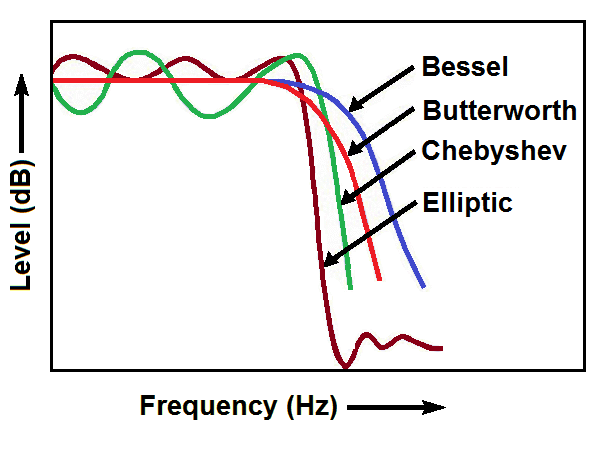
filter – (1) A device that amplifies (boosts), passes, or attenuates (reduces) audio signals of a given range of frequencies. The upper or lower frequency that defines the range is called the cutoff frequency. Several filter designs are used such as the Chebyshev filter, the Butterworth filter, the elliptic filter, and the Bessel filter. Filters can be either active or passive. See also lowpass filter, highpass filter, bandpass filter, bandstop filter, allpass filter, notch filter, and slot filter. (2) To boost or reduce audio signals of certain frequencies allowing others to pass. Also called audio filter.
filter capacitor – a capacitor used to filter out undesirable frequencies. They are commonly used in electrical and electronic equipment to remove unwanted frequencies from audio, to remove noise, to remove radio frequency interference, to smooth dc power supplies, to suppress arcs, and many more applications.
filter cutoff – an adjutment on a synthesizer or sampler that sets the cutoff frequency of the filter.
filter order – the degree to which the mathematics of filter design is taken. Increasing order increases the roll-off slope and brings the filter closer to an ideal filter, but also increases the latency. For example, a third order filter will perform better than a second order filter, but will take longer.
finalize – to close an optical disc (OD) so that it can be read or played in a player other than the one in which it was recorded. Most OD recorders allow multisession recording, which means additional data can be added after an initial recording session. However, most other players cannot read this information until the disc is finalized, after which no additional data can be added. During finalization, a table of contents (TOC), subcodes, and other information is added to a compact disc. Finalization is the last step in the DVD authoring process, in which menus, directories, and other information is added. British spelling is finalise.
finalization – see finalize.
final mix – (1) The last mix of a multitrack recording that will be used to create the master track or for film production. (2) The two-track stereo recording that has been bounced down from a multitrack recording.
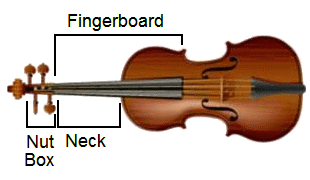
fingerboard – a flat or slightly rounded strip on the neck of a stringed instrument, against which the strings are pressed to shorten the vibrating string length and produce various pitches. See also fretboard.
fingerboard radius – see radius.
fingerpick – (1) A pick worn on the finger. Sometimes called a thimble. (2) To play a string instrument, such as a guitar or banjo, by plucking its strings with the fingers or a fingerpick. Also spelled finger pick.
fingerpicking – (1) A guitar playing technique in which the thumb maintains a steady rhythm, usually playing an alternating bass patterns on the lower three strings, while the middle finger and/or index finger pick out the melody and fill-in notes on the upper strings. Also called thumb picking, alternating bass, or pattern picking. See also fingerstyle. (2) A genre of music using the fingerpicking technique to play a specific type of folk, country, and blues music.
fingerstyle – a guitar playing technique in which the strings are plucked with the fingertips, fingernails, or fingerpicks, as opposed to picking strings with a pick (flatpicking). Often used synonymously with fingerpicking, although fingerpicking can also refer to a specific tradition of folk, blues, and country guitar.
finishing groove – see concentric groove.
finite impulse response (FIR) filter – a digital filter whose impulse response has a finite duration, returning to zero in finite time. It looks back in time to a fixed number of previous samples in order to generate a result. This is in contrast to a infinite impulse response (IIR) filter, which usually has internal feedback and continues to respond indefinitely. An FIR filter is only digital, as they cannot be constructed from analog components. An FIR filter is computationally intensive and introduces considerably more latency than an IIR filter. For a minimum-phase filter, an IIR design works well, but for a linear-phase filter, an FIR design is most commonly used.
fipple – the mouthpiece of a recorder, flageolet, or similar wind instrument that is blown endwise, consisting of a thin channel cut through a block (usually of plastic) that directs a stream of air over a sharp edge.
fipple flute – an end-blown flute-like wind instrument that has a fipple (mouthpiece), such as the recorder or flageolet.
FireWire – an interface standard for interconnecting computers and peripheral devices developed by Apple. It is one of the main methods of connecting audio interfaces with computers, the others being USB and Thunderbolt. FireWire is a subset of the SCSI-3 standard, known as IEEE 1394. It is sometimes called serial SCSI because it is a serial protocol that also conforms to SCSI standards. Firewire 400 has speeds up to 400 Mbps and uses a 6-pin connector. Firewire 800 has speeds up to 800 Mbps and uses a 9-pin connector. Although Apple essentially abandoned FireWire in 2008, it is still used on some older devices.
FireWire 400 – see FireWire.
FireWire 800 – see FireWire.
FIR filter – Finite Impulse Response filter.
first generation – a term meaning original, as opposed to a copy. The second generation refers to the first copy of the original.
first-order filter – see slope, definition #3.
first reflection – see initial reflection.
first reflection point – the point on a wall or surface from which the initial reflection occurs.
first wavefront law – see Haas effect
fishpole – slang for boom microphone.
Fitzroy formula – a formula developed by Dariel Fitzroy for estimating reverberation times. The formula is:

where k = (24 × ln 10)/C20 = 0.16 s/m or 0.049 s/ft, V is the volume of the enclosed space (in m3 or ft3), and S is the effective absorbing area (in m2 or ft2), x, y, and z are the total areas of two opposite parallel walls (in m2 or ft2), and αx, αy, αz are the average absorption coefficients of a pair of opposite walls, and C20 = speed of sound at 20°C = 343 m/s or 1126 ft/s. Also called the Fitzroy equation. See Estimation of Reverberation Time Using a Modified Fitzroy Equation for more details. Other formulas used for estimating reverb times include the Sabine formula and Eyring formula. The accuracy of these formulas vary with their complexity.
fixed point number – a number represented with a fixed number of digits after (and sometimes before) the decimal point, as opposed to a floating point number, which is more complicated and somewhat more difficult to use in computers. Fixed-point numbers can be easily used to represent fractional values (usually in base 2 or base 10) using a computer and usually provides improved performance or accuracy in a given application, but they are not as flexible in usage as floating point numbers. See also fixed point number and 32-bit floating point.
fix it in the mix – a common expression in the recording studio that refers to the concept that if you have a great performance with just a few minor flaws, it is better to use that performance and fix those problems during mixing. Some things that usually cannot be fixed in the mix include (a) an emotionless performance, (b) recording multiple performers with one microphone, or (c) using the wrong instrument or the wrong arrangement. Fixing imperfections and correcting mistakes after recording is an established method of making a track sound good, but sometimes the only way to get it right is to re-record it.
FLAC – Free Lossless Audio Codec.
.flac – file extension for the FLAC format.
flageolet – a small flute-like wind instrument similar to a recorder but with four finger holes on top and two thumb holes below. Pronounced “flaj-uh-let” or “flaj-uh-lay,” it is French for small flute.
flageolet register – see whistle register.
flamenco – an art form passed on by oral tradition originating in the Andalusia province of Spain, involving simultaneous singing, dancing, guitar playing, and rhytmic hand clapping and other percussion.
flamenco guitar – a guitar similar to an acoustic classical guitar but having a thinner top and less internal bracing, used in the art of flamenco.
flamming – playing slightly off the beat.
flange – the round metal or plastic sides of a tape reel that keep recording tape aligned as it winds onto the reel.
flanger – an effects processor used to created the flanging effect.
flanging – (1) An effect created by combining an audio signal with a version of itself that has a varying delay of about 1 to 5 msec that is modulated by a LFO (low-frequency oscillator) to vary the amount of delay. This process results in a comb filter effect that produces a swishing sound. The frequency is adjusted to set the rate at which the LFO sweeps through the change in delay. The effect is similar to chorusing and phasing. Chorusing uses a longer delay of about 15 to 30 msec, which produces nice tonal variations that simulate a group of singers like a chorus. With phasing the signal is first passed through an all-pass filter, so that the phase differences of the resulting signal depends on the input signal frequency, resulting in peaks and troughs that are not harmonically related. With flanging, the phase shift is uniform across the entire spectrum which results in a comb filter with peaks and troughs that are harmonically related. (2) A hollow, swishing sound created using the flanging effect. Named for the original technique in which one tape machine was slowed by a thumb on the tape reel flange while mixing it with the original signal from a second tape machine, creating the swooshing effect. See also zero-point flanging and additive flanging.
flanking – the transmission of sound around, over, under, or through the partition or barrier separating two spaces. Examples of flanking in buildings include ductwork, piping, electrical conduits, and electrical boxes. Also called flanking transmission.
flanking transmission – see flanking.
Flash Communication Server – see Adobe Media Server
flash drive – see USB flash drive.
Flash Media Live Encoder (FMLE) – a software application developed by Adobe for live encoding. FMLE connects to Adobe Media Server or a Flash Video Streaming Service (FVSS) to stream live video on the internet that allows clients to view the stream using a Flash player.
Flash Media Server – see Adobe Media Server
flash memory – a type of computer memory that retains data in the absence of a power supply.
Flash Video Streaming Service (FVSS) – a multimedia and software platform used to stream video and multimedia over the internet using a Flash player.
flat – (1) Lower in pitch by one semitone (one half step). Also called flatted. (2) Slightly below the correct musical pitch. (3) The musical symbol (♭) used to lower a note by one half step. (4) A flat response. (5) A descriptive term for a sound, voice, or performance lacking emotion, having little dynamic range, or lacking resonance.
flat-panel loudspeaker – a class of loudspeakers that has a thin, flat membrane used as the sound producing diaphragm. Flat-panel speakers include planar magnetic, electrostatic, magnetostatic, and transverse-wave resonating panel (TWRP). Also called flat-panel speaker, flat-panel distributed-mode speaker, or distributed-mode speaker panel.
flat-panel distributed-mode speaker – see flat-panel loudspeaker.
flat-panel speaker – see flat-panel loudspeaker.
flat pick – see pick.
flat response – a frequency response that is even at all frequencies, typically within ± 2 dB.
flatted – a musical note lowered in in pitch by one semitone (one half step).
flatten – the term used by Ableton Live for render, converting a recorded track to a new track with all effects fixed, to ease CPU usage.
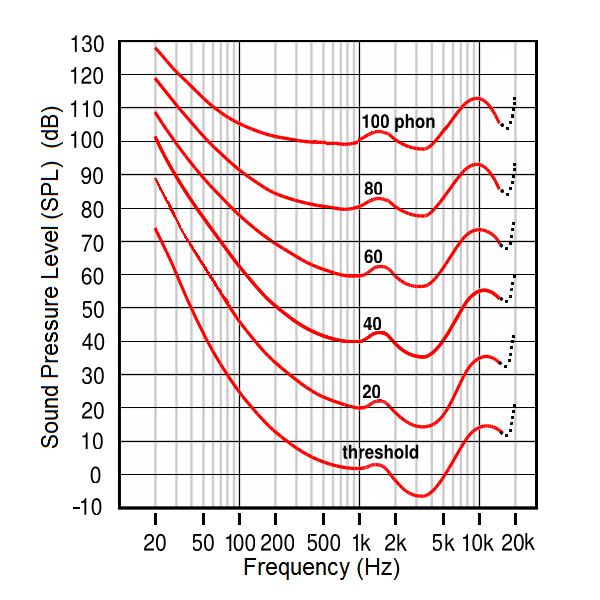
(Revised 2003)
flat-top guitar – see top, definition #2.
flat weighting – a method for measuring sound using a flat frequency response over a frequency range that must be specified. It is no longer considered a standard having been replaced by Z-weighting.
flat wind – a wind or rewind of a recording tape made at slower than the normal fast-forward speed on a tape machine. A flat wind is made so the tape winds smoothly and evenly onto the reel, minimizing edge curling and other types of deformation damage.
Fletcher Munson curves – see Fletcher Munson effect.
Fletcher Munson effect – the psychoacoustical phenomenon in which the human ear perceives much less bass and somewhat less high frequencies as the program volume is lowered. Named for the two people who discovered it, the Fletcher-Munsion curves are a set of equal loudness curves that were developed using headphones, while the Robinson-Dadson curves were developed using subjects in an anechoic room.
flicker noise – a type of electronic noise found in almost all electronic devices with a random variation in intensity (like a flickering candle). It varies inversely with frequency (1/f) and is therefore sometimes called 1/f noise. It is somewhat related to pink noise.
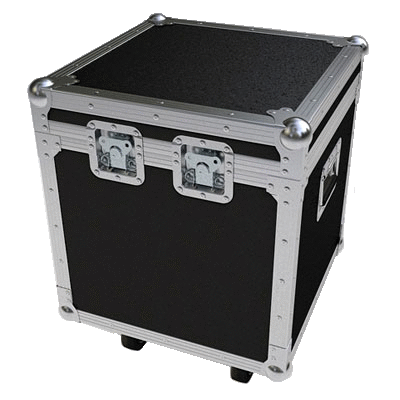
flightcase – a metal-framed wooden box, usually with reinforced corners and edges, having wheels and a removable lid used to transport equipment between venues. Sometimes called a road box.
flip side – see A side.
float – to disconnect from ground.
floating – (1) Not connected to ground. (2) In common usage, a line that is not connected to anything.
floating floor – a floor that is used in some studios that is suspended above the actual floor using sound isolating materials to minimize the transfer of exterior sounds and vibrations into the structure. See also room-within-a-room

floating pickup – a magnetic pickup that is not attached directly to the body of the instrument, but is suspended above it, typically by a pickguard or fingerboard. Floating pickups are sometimes used to avoid changing the vibrations of the instrument.
floating point number – a number using a representation of its approximate value that is similar to scientific notation, which uses a fixed number of significant digits (the significand) and an exponent in some fixed base (the base is usually two, ten, or sixteen). An example would be 1.2345 × 28. It is called floating point because the decimal point (in computers, called a binary point) can float. In other words, it can be placed anywhere relative to the significant digits of the number. See also fixed point number and 32-bit floating point.
floating shield – see telescoping shield.
floor – (1) The lower limit of a parameter. (2) Short for noise floor. (3) Another name for the range control on a gate.
floor monitor – see stage monitor.
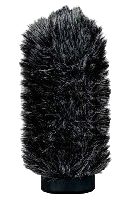
floor tom – a double-headed tom-tom drum which usually stands on the floor on three legs. Also called lower toms.
floppy disk – a flexible removable magnetic disk, typically enclosed in a plastic shell, used for storing data and programs for personal computers. They are no longer used as much as they once were having been replaced by compact discs and DVDs, which hold considerably more data. The most recent version was housed in a rigid plastic shell 3.5 inches square by about 2 mm thick that stores up to 1.44 MB of data. Prior to that was a version that came in a flexible plastic shell that was 5.25 inches square and about 1 mm thick, with a capacity of 1.2 MB. Because they were flexible they were sometimes called floppy disks or floppies although they were officially called diskettes. An 8-inch version preceded those that were primarily used on stand-alone word processors.
FL Studio – a digital audio workstation (DAW) developed by the Belgian company Image-Line. It was first introduced in 1998 as a MIDI drum machine developed by Didier Dambrin, called FruityLoops. It was soon upgraded into a full DAW. Image-Line renamed FruityLoops to FL Studio in 2003, after its attempt to obtain a US trademark was resisted by the Kellogg Company. FL Studio can use either Virtual Studio Technology (VST) or Audio Unit (AU) plugins.
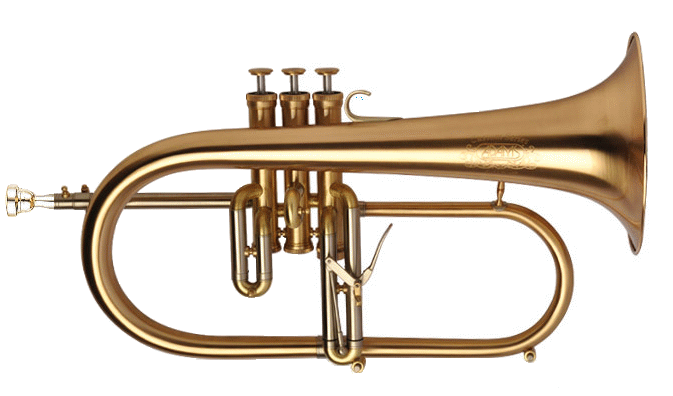
fluffy – a windscreen cover for microphones made of long synthetic fibers resembling animal fur. The long fur greatly minimizes wind noises during recording
flugelhorn – a brass instrument resembling a trumpet but larger with a wider, conical bore. Also spelled fluegelhorn, flugel horn, or flügelhorn.
flush-mounted monitors – see soffit-mounted monitors.
flute – a musical instrument in the woodwind family consisting of a metal tube with holes spaced along it that are opened and closed by a set of keys. It is held horizontally and the player blows across the mouthpiece to create a sound. There are several members of the flute family. The main instrument is called a concert flute. The picolo is a similar instrument, but is much smaller and is pitched one octave higher than the concert flute. The alto flute and bass flute are pitched a fourth and an octave respectively below the concert flute.
flute register – see whistle register.

flutter – a rapid variation in pitch caused by speed variations in audio equipment, such as turntables and tape recorders. Slow variations are called wow. See also wow and flutter. (2) A visual cue used for film scoring, consisting of a group of three to seven visual punches (small holes punched in every other frame of the film) to produce a flickering effect. A flutter is used by the composer or conductor as a metronome to sync the soundtrack music to the movie.
flutter echo – an echo that occurs very rapidly between parallel walls that produces a clicking or ringing after the original sound has ceased. So named because it sounds similar to bird wings fluttering.
flux – (1) A substance applied to surfaces that are to be joined by soldering. Flux is used to clean the surfaces, resulting in a better bond. (2) Magnetic flux.
flux density – see magnetic flux density.
fluxivity – the measure of of the magnetic flux density of a recording tape per unit of track width, measured in nanowebers per meter (nWb/m).
flyback voltage – a voltage spike seen across an inductive load when the supply voltage is suddenly reduced or removed. This voltage spike is undesirable, as it can destory solid state devices and electrical contacts. To prevent this problem, a rectifying diode is placed in parallel with the inductive load. This diode is called a flyback diode, snubber diode, freewheeling diode, suppressor diode, suppression diode, clamp diode, or catch diode. Also called an inductive spike or inductive collapse.
fly in – to copy a part of a track and paste it (fly in) to another track or another part of the same track. With a tape recorder, this process usually requires recording part of the track using a second recorder and then re-recording that copy back onto the original multitrack recording at a different place. Also called lay in.
flying erase head – a feature found on some high-quality videocassette recorders (VCRs) that makes transitions between recorded material smooth and clean. The flying erase head is mounted on and rotates with the video head drum. The flying erase head and the video record head erase and record the signal essentially instantly. Because there is no remnant of the previous signal to cause visible distortion when a cut is made, the result is a clean edit.
FM – Frequency Modulation.
FM band – see FM radio band.
FM broadcaster – a company or radio station that transmits its programming on the FM radio band.
FM broadcasting – the transmitting of radio programs using frequency modulation.
FMLE – Flash Media Live Encoder.
FM radio – the broadcasting of radio programs using frequency modulation.
FM radio band – the portion of the radio frequency spectrum from 88 MHz to 108 MHz (in the US—some countries use other ranges) and using frequency modulation.
FM receiver – (1) An electronic device (a radio receiver) that receives incoming frequency modulated (FM) radio waves and converts them into sound or data.
FM station – a radio station that transmits its programming on the FM radio band.
FM stereo – the broadcasting of a stereophonic sound on the FM radio band. In the US, FM stereo broadcasts use a multiplex (MPX) system. To maintain compatibility with mono receivers, the left (L) and right (R) channels are algebraically encoded into sum (L+R) and difference (L-R) signals. A mono receiver will receive only the L+R signal and the listener will hear both channels monophonically through a single loudspeaker. The (L+R) main channel signal is transmitted as baseband audio in the range of 30 Hz to 15 kHz. The (L-R) signal is modulated onto a 38-kHz double-sideband suppressed-carrier (DSB-SC) signal occupying the baseband range of 23 kHz to 53 kHz. A 19-kHz pilot tone (exactly half the 38-kHz sub-carrier frequency) is transmitted at 8 to 10% of overall modulation level. It is used by the receiver to regenerate the 38-kHz sub-carrier with the correct phase. The final multiplex signal from the stereo generator contains the main channel (L+R), the pilot tone, and the sub-channel (L-R), which modulates the FM transmitter. A decoder in the stereo receiver adds the difference signal to the sum signal to recover the left channel, and subtracts the difference signal from the sum to recover the right channel. Usually pre-emphasis is applied to the left and right channels before encoding and transmitting and de-emphasis is applied at the receiver after decoding, in order to preserve stereo separation and signal-to-noise ratios.
FM synthesis – see frequency modulation synthesis.
focused – a descriptive term for a sound that is easy to locate within the stereo field. The opposite of diffuse or unfocused.
Focusrite PLC – a company headquartered in High Wycombe, England, that designs and markets audio interfaces, microphone preamps, consoles, equalizers, and digital audio processing hardware and software. It was founded in 1985 by Rupert Neve as Focusrite Audio Engineering Ltd. In 2004, Focusrite acquired Novation, an electronic instrument manufacturer, becoming a subsidiary under the name of Novation Digital Music Systems Ltd. Focusrite became Focusrite PLC in 2014. In 2019, Focusrite acquired ADAM Audio. Later the same year, it acquired Martin Audio, manufacturer of loudspeaker systems for sound reinforcement. In 2021, Focusrite acquired Sequential, a maker of analog synthesizers. In 2022, Focusrite acquired the audio equipment maker Linea Research Holdings.
FOH – Front of House.
foil electret condenser microphone – see electret condenser microphone.
foil shield – a shield used on cables consisting of a thin copper or aluminum foil or polyester film backed with aluminum. A foil shield is relatively cheap and provides 100% shielding, but it severely limits flexibility and and easily breaks down under repeated flexing. However, it can be well suited in permanent installations where flexibility is not a problem. See also spiral shield, double-spiral (Reussen) shield, braided shield (mesh), and double-braided shield.
foldback – a term formerly used for monitors or monitor speakers. The term is rarely used today.
fold down – (1) To reduce a stereo recording to monophonic, as opposed to a monophonic mix created directly from a multitrack recording. (2) To mix a several audio tracks into a lower number of tracks. Also called downmix. Sometimes spelled fold-down or folddown.
folding frequency – see Nyquist frequency.
foldover distortion – see aliasing.
Foley – (1) The process of creating and recording sound effects that are added in post production of a movie. The person who creates the sound effects is called a Foley artist. The audio track that contains Foley sounds is known either as a cloth track (west coast) or rustle track (east coast), as in the rustling of clothing. Frequently, sound effects are not the actual sounds being portrayed. For example, the sound of rain can be simulated by recording the sound of frying bacon. (2) A Foley stage.
Foley artist – the person who creates sound effects on a Foley stage. Also called a Foley walker since footsteps are the most common sound effect.
Foley stage – the place where sound effects are recorded, named after Jack Foley, who is credited with inventing the concept and was in charge of sound effects at Universal Studios. Also called a Foley studio or simply Foley.
Foley studio – see Foley stage.
Foley walker – see Foley artist.
follower – a circuit element, such as a vacuum tube or op amp, in which the output voltage is same as the input, used as a impedance converter. See also cathode follower and emitter follower.
foot – (1) A unit of linear measure equal to exactly 0.3048 meter in the US customary units, as defined in 1959. There are 12 inches in a foot and three feet in a yard.
foot drum – see kick drum.
foot pedal – (1) A control operated by the foot. (2) A device where the amount of an effect can be controlled by a musician with his foot, often mounted on a pedal board. (3) A mechanism activated by the drummer's foot to activate the beater on a kick drum. (4) Levers on a piano operated by the foot used to change the sound characteristics of the instrument.
footswitch – a switch placed on the floor and pressed by a musician or engineer to perform various functions and freeing up their hands to play or handle other duties. Sometimes spelled with the less-preferrd foot switch.
foreground music – a type of music played in stores and restaurants, but unlike background music, it is designed to be heard and used as a branding tool to help retailers define an image.
forensic audio – the scientific examination, comparison, or evaluation of sound recordings to determine the authenticity, validity, origin, or other information and to provide investigators with evidence that is admissible in a court of law or other official venue.
fork connector – see spade connector.
fork terminal – see spade connector.
formant – several prominent frequency bands that makeup the characteristic sounds of an instrument or human speech. In the human voice the combination of these components produce the distinguishing characteristics of the vowel sounds and are determined by each individual's physical characteristics. That is what makes each person's voice sound unique. These bands are relatively fixed in frequency for each voice and do not vary much even when the pitch changes. The same thing occurs with musical instruments, which have a fixed set of formants that imparts its unique, recognizable timbre. That is why formant control is used with some software programs and plug-ins so as to not create a “chipmunk” effect when shifting frequencies or transposing notes.
former – a cylinder in a speaker driver around which the voice coil is wound. (See diagram.) It is attached to the back of the speaker cone so that the voice coil causes the cone to move. The voice coil and former are essentially one piece.
form factor – the size, configuration, layout, functionality, or physical shape of an object, such as a microphone. Microphone form factors include considerations such as size, shape, handheld or stand-mountable, type of mounting, end-address or side-address, etc. Sometimes spelled form-factor.
forward bias – a bias voltage applied in the direction of the current flow within a transistor, vacuum tube, or circuit, as opposed to a reverse bias, which is a voltage applied in the opposite direction.
forward masking – a form of temporal masking in which a later arriving sound is masked by an earlier louder sound. The effects occurs for periods of less than 500 ms and for sound differences of greater than 10 dB.
four buttons in – see all-button mode.
four-buttons mode – see all-button mode.
four-buttons trick – see all-button mode.
four-channel stereo – see quadraphonic.
Fourier series – see Fourier theorem.
Fourier theorem – a mathematical theorem that when used in audio or audio synthesis states that any sound can be reproduced using a combination of sine and cosine waves of various amplitudes and phases. The mathematical expression is called a Fourier series, named for French mathematician and physicist Jean-Baptiste Joseph Fourier. See also FFT, frequency spectrum, and spectrum analysis.
four-point edit – an audio edit in which the the beginning and ending points of the source audio are specified and both the beginning and ending at the insert point (on the same or a different track) is specified. A 4-point edit defines exactly how much of the existing track will be replaced. See also three-point edit and replace edit.
fourth – in music, the interval that includes four positions on the music staff. (See interval number.) A fourth has a theoretical ratio of 4:3. However, in the equal temperament system, in which the notes are spaced equally, the ratio from middle C (262.63 Hz) to F4 (349.23 Hz) is 4:3.003, or about 2 cents wider than the 4:3 ratio. While a perfect fourth has an interval of five semitones, a diminished fourth has four semitones, and an augmented fourth has six.
four-way speaker system – see 4-way system.
fps – (1) Frames Per Second. See frame rate. (2) Feet Per Second. See speed of sound.
frame – (1) One still picture in a film or video. (2) One complete SMPTE time code word synchronization. Each second is subdivided into frames that correspond to a single still image in a video file, with the number of frames in each second depending on the frame rate. (3) A small section of digital audio. (4) Six sampling periods (136 ms) on a compact disc. (5) To line up an image in the viewfinder of a camera. (6) The device that holds the cone of a loudspeaker. Also called a basket.
frame count – the number of frames counted per unit of running time (not necessarily real time) of video, film, or audio, regardless of the actual running speed. Sometimes used incorrectly for frame rate or frame speed.
frame lock – see frame synchronization.
frame rate – the number of frames that are played per unit of real time in audio, film, or video, usually measured in frames per second (fps). For example, 30 fps means that 30 frames are displayed per second. Sometimes called frame speed, especially to help differentiate it from frame count, with which is is sometimes incorrectly interchanged. See also field rate and refresh rate. Here are some standard frame rates:
| Medium | Frame Rate (fps) |
|---|---|
| Film (35 mm) | 24 |
| Film (EBU) | 25 |
| PAL | 25 |
| NTSC black & white | 30 |
| NTSC color | 29.97 |
| ATSC | 30 (i) 60 (p) |
frame sync – see frame rate.
frame speed – short for frame synchronization.
frame synchronization – the process of synchronizing video display scanning to a synchronization signal, which is fed from a master to the slaves in the system. The timing or alignment of the video frame is adjusted so that the start of the upper left corner scan line of the image occurs simultaneously on all video equipment in the system. Synchronization is necessary in both analog and digital systems in order to perform video effects and glitch-free source switching. Also called frame sync or frame lock. See also generator locking.
Fraunhofer IIS – The Fraunhofer Institute for Integrated Circuits. See Fraunhofer Society.
Fraunhofer Institute – see Fraunhofer Society.
Fraunhofer Society (Fraunhofer-Gesellschaft zur Förderung der angewandten Forschung e.V.) – Fraunhofer Society for the Advancement of Applied Research. A German research organization made up of 69 institutes and research units located throughout Germany. It was named after Joseph von Fraunhofer, a German scientist, engineer, and entrepreneur. The Fraunhofer Institute for Integrated Circuits (Fraunhofer IIS) provides research and development of microelectronics and IT systems. Fraunhofer IIS was instrumental in the development of MP3 and AAC and provided a significant role in digital cinema. It is commonly called the Fraunhofer Institute.
freedb – a database of compact disc track listings, operating under the GNU General Public License. Various apps and media players can use freedb to look up CD information over the internet. The program calculates a value from the CD table of contents to create a fairly unique disc ID to query the database. If the CD is found in the database, the app can retrieve and display the artist, album title, track list, and other information. Originally, the CDDB database was used for this purpose and was free. In 2001, Gracenote, Inc. became the owner of CDDB, changed the license so that it was no longer free, and banned all unlicensed applications from accessing their database. The freedb project was developed so that its database could remain free. The freedb is used primarily by media players, catalogers, audio taggers, and CD ripper software. In 2006, Magix acquired freedb. In 2007, MusicBrainz released their project, which uses their own database rather than freedb. Sometimes shown as free-db.
Freedman Electronics Group Pty Ltd. – a pro-audio company headquartered in Sydney, Australia, that was founded as Freedman Electronics in 1967 by the husband-and-wife team of Henry and Astrid Freedman as the Australian distributor for the German manufacturer Dynacord. It later expanded into a wide range of audio products including loudspeakers, amplifiers, and microphones. When Henry Freedman died in 1987, his son Peter took over the business, which had fallen on hard times. Peter began importing Chinese-made microphones, which eventually led to the establishment of RØDE Microphones as a subsidiary. Most of the microphone manufacturing later was moved to Australia. In 2006, Freedman bought loudspeaker manufacturer Event Electronics. In 2015, it acquired Aphex (formerly Aphex Systems), manufacturer of products for the professional audio, broadcast, live sound, and home recording markets. In 2016, Freedman acquired SoundField from TSL Professional Products Ltd
free lossless audio codec (FLAC) – an audio data compression scheme that typically reduces music files by up to 50%, but is lossless since there is no loss of the frequency response, dynamic range, or timbre from the original signal, unlike typical codecs like MP3 or AAC, which discard portions of the audio information to create a smaller file size.
free field – the area in a room where sound waves produce no reflections. Since all rooms have at least a small amount of reverberation, there is no such thing in the real world as a true free field. It must be approximated in an anechoic chamber. See also far field, near field, and reverberant field. Also called full space.
free-field microphone – see microphone response types.
free-reed instrument – a musical instrument that produces sound by air flowing over a vibrating reed in a frame, with air pressure typically generated by breath or bellows. Examples include accordion, harmonica, and harmonium (reed organ).
free-running – using an internal clock in a digital device rather than using synchronization from an external clock.
free-space placement – see free-standing placement.
free-standing placement – placing a loudspeaker (or monitor) on the floor, a stand, or a shelf, as opposed to being wall-mounted. Sometimes called free-space placement.
freeze function – a process on some DAWs that bounces each designated track to a new file to save processing power. Depending on the DAW, all or some plugins and automation are rendered during this process. See also commit.
French braid – see double-braided shield.
French harp – see harmonica.
French horn – a brass instrument with a tube coiled in a circle, valves, and a wide bell, played with the right hand in the bell to soften the tone and affect the harmonics.
French pitch – See A440.
frequency (ν) – (1) The number of cycles per second of a waveform measured in hertz (Hz). Frequency is related to wavelength according to the formula V = ν × λ, where V is the velocity of sound, the Greek letter nu (ν) is the frequency, and Greek letter lambda (λ) is the wavelength. The frequency of a sound determines its perceived pitch. See also amplitude. (2) The number of times a process is repeated in a given time. (3) The frequency assigned by a government agency (such as the FCC in the US) for a specific transmitting purpose, such as that assigned for a radio station or a wireless microphone.
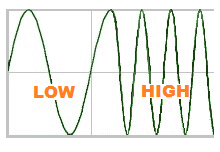
frequency agile – having the ability to easily change frequencies.
frequency allocation – the assignment by various government agencies (FCC, ITU, etc.) of specific frequencies in the radio-frequency spectrum to specific stations and for specific purposes to provide for maximum utilization of frequencies and to minimize interference between stations. Sometimes called spectrum allocation.
frequency band – a range of frequencies within the electromagnetic spectrum, radio-frequency spectrum, or audio spectrum. For example, a 10-band graphic equalizer has 10 frequency bands that can be adjusted. Also called a frequency range or band for short or, in the RF spectrum, radio frequency band.
frequency bracketing – restricting the frequency content of an audio signal by applying low- and high-pass filters to the sound, essentially removing most of the content outside the bracket. Bracketing helps carve out a space for a sound in a dense mix, and it helps keep the sound from interfering with other similar sounds. A steeper filter will produce greater separation, with a filter-slope between 12 dB/octave and 24 dB/octave typically being used. Sometimes called simply bracketing.
frequency deviation – the maximum instantaneous difference between a modulated frequency and the unmodulated carrier frequency. Frequency deviation should not be confused with frequency drift. Also called modulation index, modulation depth, or simply deviation for short.
frequency distortion – the distortion in an audio signal in which a flat frequency response is no longer flat across the full bandwidth, that is, some frequencies are attenuated more than other frequencies. Also called attenuation distortion.
frequency domain – the analysis or measurement of systems, functions, or signals with respect to frequency, rather than time. For example, a frequency-domain graph shows the amount of the signal that lies within each frequency band plotted by frequency. See also time domain.
frequency doubling – a type of distortion that can occur when a loudspeaker is overdriven causing the second harmonic of a tone to be louder than the fundamental pitch.
frequency drift – the unintended change from the desired carrier frequency of a radio signal.
frequency-hopping spread spectrum (FHSS) – a method of transmitting radio signals to minimize interference by rapidly switching frequencies among many channels, using a sequence synchronized with the transmitter and receiver.

frequency magnitude response – a curve of attenuation vs frequency for a given filter. Filter performance is also described using the phase response of the filter.
frequency masking – when two or more sounds occur at the same time in the same frequency range causing some of them not to be heard. Human hearing tends to blend simultaneous sounds into a single, composite sound. Sounds with similar frequencies can either become dominant or can cause one sound to mask another. Also called band masking or auditory masking.
frequency mixer – an electrical circuit that creates new frequencies from two other frequencies, typically producing two new frequencies equal to the sum and difference, but other frequencies may be produced.
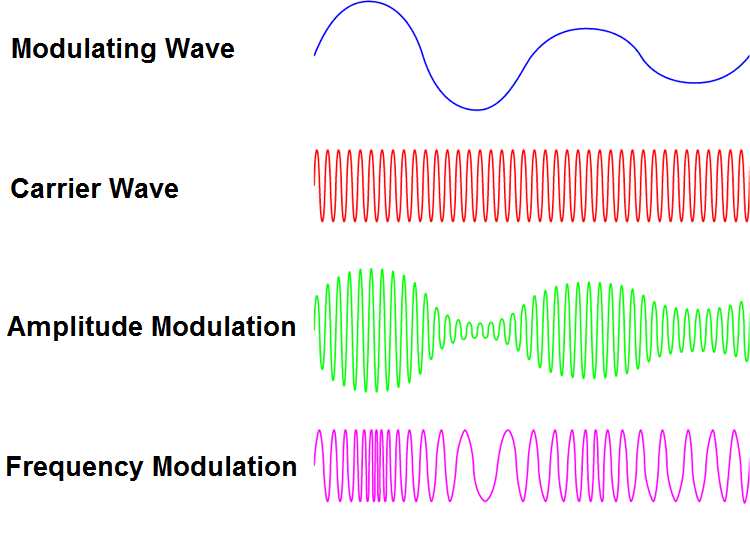
frequency modulation (FM) – (1) A method of changing a waveform by altering (modulating) its frequency in response to an input signal. (2) A radio broadcast method that uses frequency modulation.
frequency modulation distortion – a type of distortion caused by sound reproducers modulating a signal, and occurs in loudspeakers, phonographs, tape machines, and film soundtracks. Examples of frequency modulation distortion are wow and flutter and Doppler distortion.
frequency modulation synthesis – a method of sound synthesis using frequency modulation (FM). Once called cross modulation synthesis. See also AM Synthesis, additive synthesis, subtractive synthesis, sample synthesis, and wavetable synthesis.
frequency range – (1) In general, a range of frequencies. (2) The range of frequencies that a device (such as a loudspeaker) is capable of reproducing. (3) The range of frequencies to which a transducer (such as a microphone) is capable of capturing. Although technically different from frequency response, the two terms are often used interchangeably. (4) A range of frequencies upon which a processor, such as an equalizer, acts. Also called a frequency band.
frequency ratio – the ratio of the frequency of the higher pitch to the that of the lower pitch in a musical interval. Also called an interval ratio.
| Interval | Frequency Ratio |
Cents | Augmented Diminished |
|---|---|---|---|
| Unison | 1.000000:1 | 0 | Diminished Second |
| Minor Second | 1.059463:1 | 100 | Augmented Unison |
| Major Second | 1.122462:1 | 200 | Diminished Third |
| Minor Third | 1.189207:1 | 300 | Dimished Second |
| Major Third | 1.259921:1 | 400 | Diminished Fourth |
| Perfect Fourth | 1.334840:1 | 500 | Augmented Third |
| Tritone | 1.414214:1 | 600 | Diminished Fifth Augmented Fourth |
| Perfect Fifth | 1.498307:1 | 700 | Diminished Sixth |
| Minor sixth | 1.587401:1 | 800 | Augmented Fifth |
| Major Sixth | 1.681793:1 | 900 | Dimished Seventh |
| Minor Seventh | 1.781797:1 | 1000 | Augmented Sixth |
| Major Seventh | 1.887749 :1 | 1100 | Diminished Octave |
| Octave | 2.000000:1 | 1200 | Augmented Seventh |
frequency resolution – see resolution.
frequency response – (1) The range of frequencies that a device (such as a loudspeaker) is capable of reproducing within a given tolerance, such as ±2 dB. (2) The range of frequencies to which a transducer (such as a microphone) is capable of capturing within a given tolerance in db. Although technically different from frequency range, the two terms are often used interchangeably.

frequency response curve – a graph of the frequency response of a device showing the amplitude vs. the frequency.
frequency response errors – any deviation from a flat frequency response in an audio device.
frequency search – the process, usually performed by a computer program, of scanning frequencies for a wireless microphone that are unused and free from interference in a particular location.
frequency shifter – a plugin or processor that that adjusts the frequency of a note and all its harmonics by the same amount of frequency. See frequency shifting for details. Compare with pitch shifter.
frequency shifting – raising or lowering the frequency of a note and all its harmonics by the same amount of frequency. Frequency shifting is similar to pitch shifting, except that pitch shifting moves all the harmonics of a sound up or down by the same pitch, thus maintaining its harmonic integrity. Frequency shifting usually does not sound good on a pitched sound, but on unpitched sounds like percussion it can create sub-bass extension while maintaining the integrity of a drum's attack phase much better than with pitch shifting.
frequency spectrum – a representation of a signal in the frequency domain, which is generated using a Fourier transform of the signal [an explanation of which is beyond the scope of this glossary]. These values are usually presented as amplitude and phase plotted versus frequency. Any signal that can be represented as an amplitude and varies over time has a corresponding frequency spectrum, such as visible light, audio signals, and radio signals.See also spectrum analysis.
frequency stability – the ability of a radio transmitter or an oscillator to maintain a desired frequency, usually expressed as percent deviation from the desired frequency.
frequency synthesizer – an electronic circuit that generates a range of frequencies from a single fixed clock or oscillator. They are used in many devices, including radio receivers, transmitters, mobile telephones, and GPS systems.
frequency weighting – see weighting.
frequency zones – the frequency ranges in a room in which sound acts in different ways. There are four frequency zones into which the behavior of sound can be divided. These frequency ranges are approximate and depend on the room size. (a) Zone 1 is below the frequency having a wavelength of twice the longest length of the room. In this zone, sound behaves much like changes in static air pressure. (b) Zone 2 has frequencies with wavelengths that are comparable to the dimensions of the room. In this zone, room modes dominate. The transition frequency between zone 2 and 3 is called the Schroeder frequency or the cross-over frequency. It is the transition between the low frequencies at which standing waves occur in small rooms and the mid frequencies. (c) Zone 3 extends approximately 2 octaves above the frequencies in zone 2. (d) Zone 4 is where sound behaves like light rays bouncing around the room.
fret – (1) One of several bars or ridges set across the fingerboard of some stringed instrument, such as a guitar. (On a guitar each fret represents one semitone.) Also called a fret bar. (2) To press the strings of such an instrument against the frets.
fret bar – see fret.
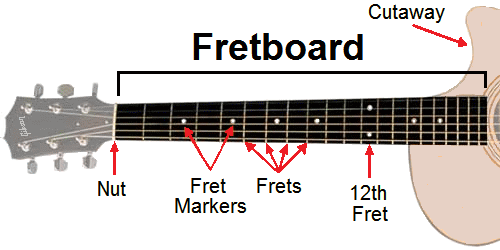
fretboard – a fingerboard on a guitar or other string instrument that has frets.
fret buzz – an rattling or buzzing sound that occurs when a vibrating string strikes a fret that is higher than the fretted note. Fret buzz can be caused by low action, improperly installed frets, loose strings, or improper relief of the guitar neck. Sometimes called fret noise.
fret-hand muting – a guitar playing technique using the fretting hand (the left hand for most people) to damp or mute the strings of an instrument while strumming with the other, producing a percussive sound with no ringing of the strings. Compare with palming, which uses the picking hand. Some people say fret-hand muting is synonymous with muted strumming, but others say the term implies an occasional mute rather than continuous strumming. Also called muting or chucking.
fret markers – inlays often found on fretted instruments, to aid in navigating the fretboard. These are often dots, but can be diamonds, squares, or other shapes or designs. On guitars they are usually found at the 3rd, 5th, 7th, 9th, 12th, 15th, 17th, 19th, 21st, and 24th (if present) frets. The 12th fret and 24th fret often have double dots to indicate an octave. However, the patterns vary widely from one manufacturer to another. Also called dot markers or marker dots.
fret noise – can refer either to fret buzz or string squeak.
fret number – the number of a fret, counting from the nut, used in tablature to indicate where a player should place a finger. A 0 (zero) indicates an open string. For example, if a tab had fret number 4 shown on the second string, the player should place a finger on the second string at the fourth fret.
fret squeak – see string squeak.
fretting – (1) Pressing down a string on an instrument behind a fret with a finger or fingers so that when the string is plucked, strummed, or bowed, it produces the desired note or chord. (2) The system of arranging or placing frets on an instrument.
fretting hand – when playing a fretted stringed instrument, the hand placed on the neck and used to hold down (fret) the strings to select the notes or chords that are played when the string is plucked, strummed, or bowed. For right-handed players, usually the left hand is used for fretting, while left-handed players often use the right hand. However, some left handers prefer to play right-handed and fret with their left hand (their dominant hand) which can sometimes be an advantage. See picking hand.
fringe area – an area remote from a transmitter where reception becomes poor due to weak signals and high interference.
fringing – playing back an audio tape in which the tape head is narrower than the recorded track on the tape, which results in increased low frequencies.
FRFR – Full Range, Flat Response. See FRFR speaker.
FRFR speaker – a guitar speaker with full range and flat response. A typical guitar speaker has a frequency response in the range of 80 Hz to 5,000 Hz or so. To take full advantage of some of the effects, a guitarist will sometimes choose an FRFR speaker, which performs more like a high fidelity speaker.
frontal incidence microphone – see microphone response types.
front electret condenser microphone – see electret condenser microphone.
front end – the part of the circuitry of a radio receiver into which the radio signal is input.
front of house – (1) A theatrical term for the portion of a building that is open to the public, typically the auditorium and foyer, as opposed to the stage and staging areas. (2) In live venues, the components of a PA system that are directed toward the audience, as opposed to the monitoring system, which is called the back of the house (BOH).
front-to-back imaging – see depth, definition #1.
FS – Full Scale.
fS – Fundamental Sample rate. It is usually preceded by a factor which is a multiple of the the fundamental sample rate. For example, if the fundamental sample rate is 44,100 Hz, then 2fS would be 88,200 Hz. With a fundamental sample rate of 48,000 Hz, 2fS is 96,000 Hz. It is frequently used when discussing DSD, where 64fS is 64 times the standard CD sample rate or 2.8224 MHz, sometimes indicated as DSD-64 (single-rate DSD) and 128fS is 128 times the CD sample rate or 5.6448 MHz (DSD-128 or double-rate DSD). Sometimes shown as fs. Not to be confused with FS meaning full scale or or fs meaning sampling frequency.
fs – abbreviation for sampling frequency or sample rate.
FSD – Full Scale Defelection.
FSK – Frequency Shift Key. An audio tone sent as a clock signal to synchronize a sequencer with an audio tape.
FSM – Feedback Stability Margin. The safety margin for the acoustic gain of a sound-reinforcement system to minimize acoustic feedback problems.
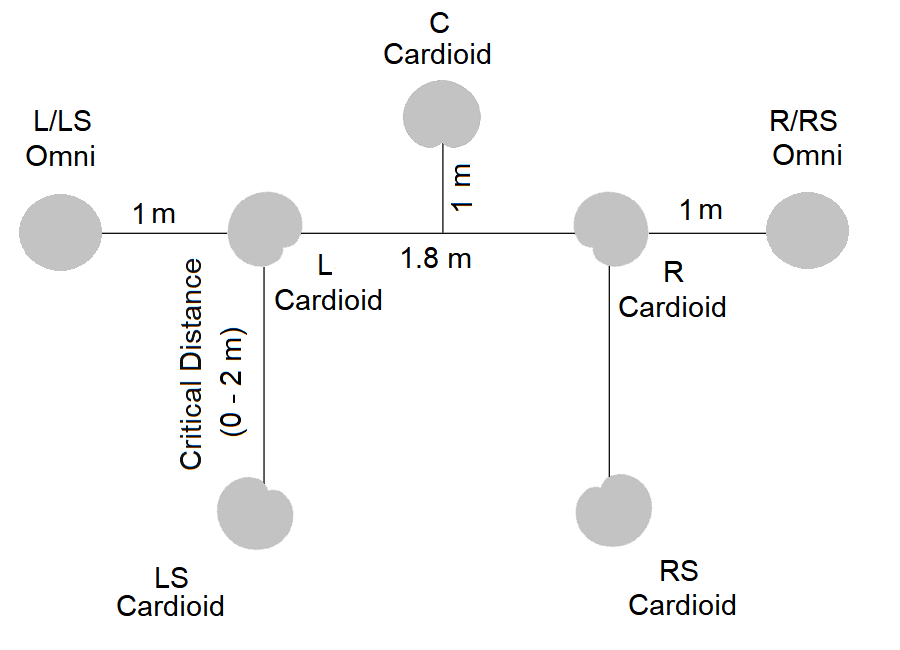
Fukada tree – a surround sound microphone technique developed by Akira Fukada, a recording engineer with NHK Science & Technical Research Laboratories. The front array consists of three cardioid microphones similar to a Decca tree, with two cardioids spaced 1.8 meters (6 ft) apart, and the center microphone placed 1 meter (40 in) forward, producing a strong center image. Two additional omnidirectional microphones can be added on the left and right to enlarge the perceived image size or to better consolidate the front and surround channels. The rear array consists of two cardioids spaced about 1.8 meters (6 ft) apart. The left and right mics are angled at 45° from the center microphone and the rear mics at 135°. The surround microphones are positioned at the critical distance, the point at which the direct sound and reverberant field is equal. The array should be placed several meters above and behind the conductor.
full – a descriptive term for a sound that has an even distribution of frequencies, especially the lower frequencies. Fullnes depends on the sound source. For example, males voices are full around 125 Hz, female voices around 250 Hz, violins around 250 Hz, saxophones in the 250 to 400 Hz range. Opposite of thin.
fullband de-esser – see split-band de-esser.
full bandwidth – refers to an audio file that has not been compressed, retaining its original resolution and sample rate.
full bend – see bend.
full code – see full scale, definition #2.
full-duplex – the ability of a line, channel, or device to send signals simultaneously in both directions. For example, a telephone is full-duplex because both parties can speak at the same time. By contrast, a walkie-talkie is half-duplex because only one person can transmit at a time. In audio, this term is most commonly used with computer sound cards, where a full-duplex audio card can record and playback at the same time.
full high definition – see 1080i.
full-length – a term sometimes used to describe an album to distinguish it from a single or EP.
full normal – see normal.
full-range – being capable of capturing, reproducing, processing, or otherwise handling the entire audio frequency spectrum of 20 Hz to 20 kHz.
full-range driver – a speaker driver that can reproduce the entire audio frequency spectrum from 20 Hz to 20 kHz.
full scale (FS) – (1) In an analog system, the maximum voltage available, full scale deflection (FSD), or maximum indication of an indicator. (2) In a digital system, the maximum voltage that can be handled, indicated as 0 dbFS. Also called digital full scale or full code, as the digital representation is all 1s.
full scale deflection (FSD) – the maximum deflection of a meter.
full score – a musical score in which the parts for all the instruments or vocals, are indicated and aligned one above the other.
full space – see free field.
full track – a single track recorded across the total width of the magnetic recording tape.
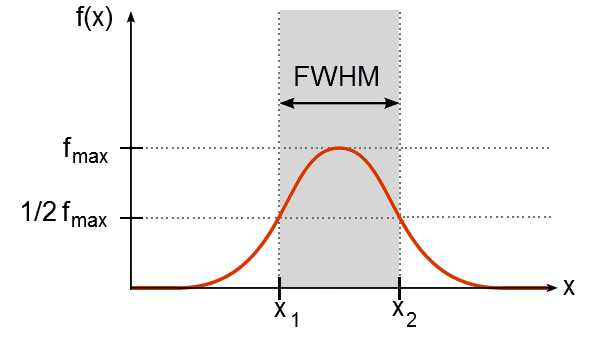
full width at half maximum (FWHM) – the mathematical function in which the difference between the two extreme values of an independent variable where the dependent variable is equal to half of its maximum value. That is, the width of a spectrum curve measured between the points on the y-axis where the amplitude is half the maximum value. FWHM is used to measure pulse waveforms. It is also used in signal processing to define bandwidth as the width of the frequency range where half the power of the signal is attenuated, the 3-dB down point or the half-power point. Half width at half maximum (HWHM) is half of the FWHM. Full duration at half maximum (FDHM) is the preferred term when the independent variable is time.
functional harmony – a theory of tonal music that regards every chord as having a function, categorized as either predominant, dominant, or tonic. The function of a predominant chord is to get you to the dominant chord, and the function of a dominant chord is to get you to the tonic chord. The tonic chord is the tonal center, to which all other chords resolve. (Tonal chord progressions tend to move via the circle of fifths).
fundamental – (1) Pertaining to or produced by the lowest component of a complex vibration. (2) The lowest frequency in a harmonic series. (3) The lowest frequency making up the pitch of a musical instrument. See also harmonic.
fuse – a safety device consisting of a low melting-point conductor that melts and breaks the electric circuit when the rated level of current is exceeded. See also circuit breaker.
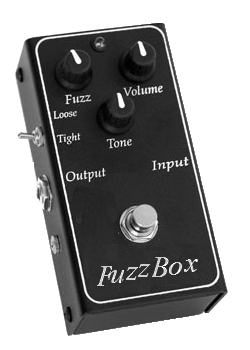
fusion – the perception that sounds from two or more loudspeakers are being produced by a single audio source.
fusion zone – the area in which all reflections arrive at the ear of the listener within 20 to 40 ms after the direct sound, so that they are integrated (fused) together, resulting in an apparent increase in level and a pleasing change of character. See Haas effect.
fuzz box – a distortion effects device that creates “warm,” “dirty,” and “fuzzy” sounds by compressing the peaks of an audio signal and by adding overtones, typically used with electric guitars. Also called a fuzz tone.
fuzz tone – see fuzz box.
fuzzy – a descriptive term for a distorted sound with vibrational character, such as that produced with an electric guitar using a fuzz box.
FWHM – Full Width at Half Maximum.
FX – abbreviation for effects, sound effects, or special effects.
Note: We believe this is the largest dictionary (glossary) of terms specific to usage within the recording industry that is currently available on the internet, with more than 8,800 entries, nearly 800 illustrations, and dozens of tables. Some of the terms have different or additional meanings in other situations, especially within the electronic, automotive, scientific, and computer industries. Of necessity there are obvious overlaps into other fields such as music, electronics, and computers, but such excursions are limited to information deemed pertinent to the knowledge required to operate and/or participate effectively in the workings of a recording studio. Also included are terms related to sound reinforcement (live performances) including wireless microphone technology because a working knowledge of that terminology is necessary for recording at live performance venues. Because recording studios also record audio for video and motion pictures (films), some terminology from those fields is included. Some scientific terms are included because they help explain studio terminology. For example, electromagnetism explains how microphones, loudspeakers, and guitar pickups work. Knowledge of radio waves and the radio frequency spectrum is needed to explain wireless devices. Any trademarks or trade names mentioned belong to their respective owners. The information contained in this dictionary is believed to be accurate at the time of publication. This information is subject to change without notice. The information was obtained from and cross-checked with a variety of sources that are believed to be reliable. However, Los Senderos Studio, LLC does not guarantee the accuracy or completeness of the information contained herein. Please contact us to report any errors, omissions, discrepancies, or broken links. Los Senderos Studio shall not be responsible for any consequences or damages arising out of the use of this information. Nothing in this glossary should be interpreted as legal advice. For a glossary providing information on legal and business matters for musicians, we suggest you consult Musicians Business Dictionary.
A note on alphabetical order: The terms in this glossary are alphabetical without regard to spaces and punctuation. For example, AM Radio follows amplitude. While this may seem to be at odds with other conventions, it eliminates confusion with words such as pickup, which is sometimes written as pick up or pick-up. In addition, all symbols such as &, -, or / are ignored. The entries on the number page (0-9) are listed in increasing value within each digit. For example, all of the entries beginning with 1 are listed before those starting with 2. For Greek letters (α-ω), the entries are in Greek alphabetical order.


